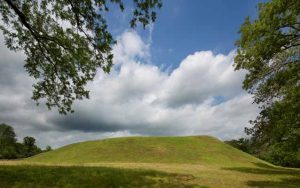On the 18th of May 1838, a party of literary and scientific gentlemen from Natchez, Mississippi, examined two square mounds three and a half miles below the city, between the bluff and the river, about a mile from the river and one-eighth of a mile from the bluff, rising from 11 to 16 feet above the level upon which they are based. The two mounds stood about 500 feet apart, ranging north and south of each other, the larger being 66 feet square, and 16 feet high, and the other 33 feet square and 11 feet high. An excavation was made in the latter clear to the bottom and, as usual human bones and numerous and various pieces of Indian pottery; and trinkets were found at different depths; as both structures were similar, no excavation was made in the larger one. On the 20th of May 1838, a party of 25 men from Natchez visited a large mound standing about 10 miles east of that city. On approaching the mound from the west, states the writer, it presents the appearance of a long, straight battery of earth, with a sloping, regular front and platform at the top, with a few moderate elevations or towers upon the terrace, the whole being over looked by an abrupt tower at the eastern end towards Natchez; which rises nearly as high above the terrace or platform as that does above the circumjacent plain. In approaching the mound on the southern side, it presents a most imposing and martial character, and the traces of de sign are so apparent that the observer cannot but ascribe it to the work of man, and involuntarily feels that so enormous a pile must have been the creation of heads that planned, and hands that labored through long periods of time. Its magnitude however did not impress the beholder at first with its full proportions; but after ascending, its steep face to the broad terrace, which is itself the base of the great western tower and also of four other smaller ones, and glancing” at the general outline of the foundation mound, which has the appearance of a parallelogram, with a regular southern side and an irregular front on the north, then walking over the terrace which includes an area of nearly five acres, and looking up at the western tower, it self a parallelogram (perhaps once a perfect one) of 80 or more feet in length and 50 in breadth, the mind fully comprehends the vastness of the structure, and allows due honor to the prehistoric ancestors of the North American Indian race, who have left behind them such a mysterious hieroglyphic of power, speaking a language of grandeur, yet without a relic of a single word that we may translate into the elements of history. The height of the greater race, from its base, was, in 1838, 45 feet by measurement, and of the great tower above the terrace, 38 feet, making 83 feet in all above the plain.

The human skeletons, from the great length of time they had been immured, prevented the examining party from obtaining but few perfect specimens of craniology. At the depth of about two feet from the surface they found the skeleton of a full sized man from which, no doubt, much earth must have washed away during the long years that had passed since there entombed. The skull was indisputably a compressed one of a Flat Head Indian, or one whose head in infancy had undergone the compressing process, a custom, it is said by the early writers, practiced by the ancient ancestors of the present Choctaws.
The sides of the larger mounds are nearly wholly encased about one foot beneath the surface of the earth with a kind of rubbish resembling slack baked bricks, regardless of regularity of form, as if laid upon the original steep faces of the mound to prevent the washing away of the soil. This rude roofing, formed of a clay base, mixed with hair or moss, like modern mortar, may once have been continuous, or it may not have been otherwise than it was when discovered; in either case it was a sufficient security against the action of rainwater. The soil above the rubbish was filled with fragments of pottery, pieces of human and animal bones, charcoal and the debris of the top of the mound and of the smaller towers, which seem to have been almost entirely washed away. The pottery found was made of different colors; some pieces were brick colored; others slate colored; others white. The pieces were large enough to show the shape and curve of the circumference of the vessels of which the pieces were a part. Some of the pieces proved the original to have been of beautiful structure.
Discover more from Access Genealogy
Subscribe to get the latest posts sent to your email.
